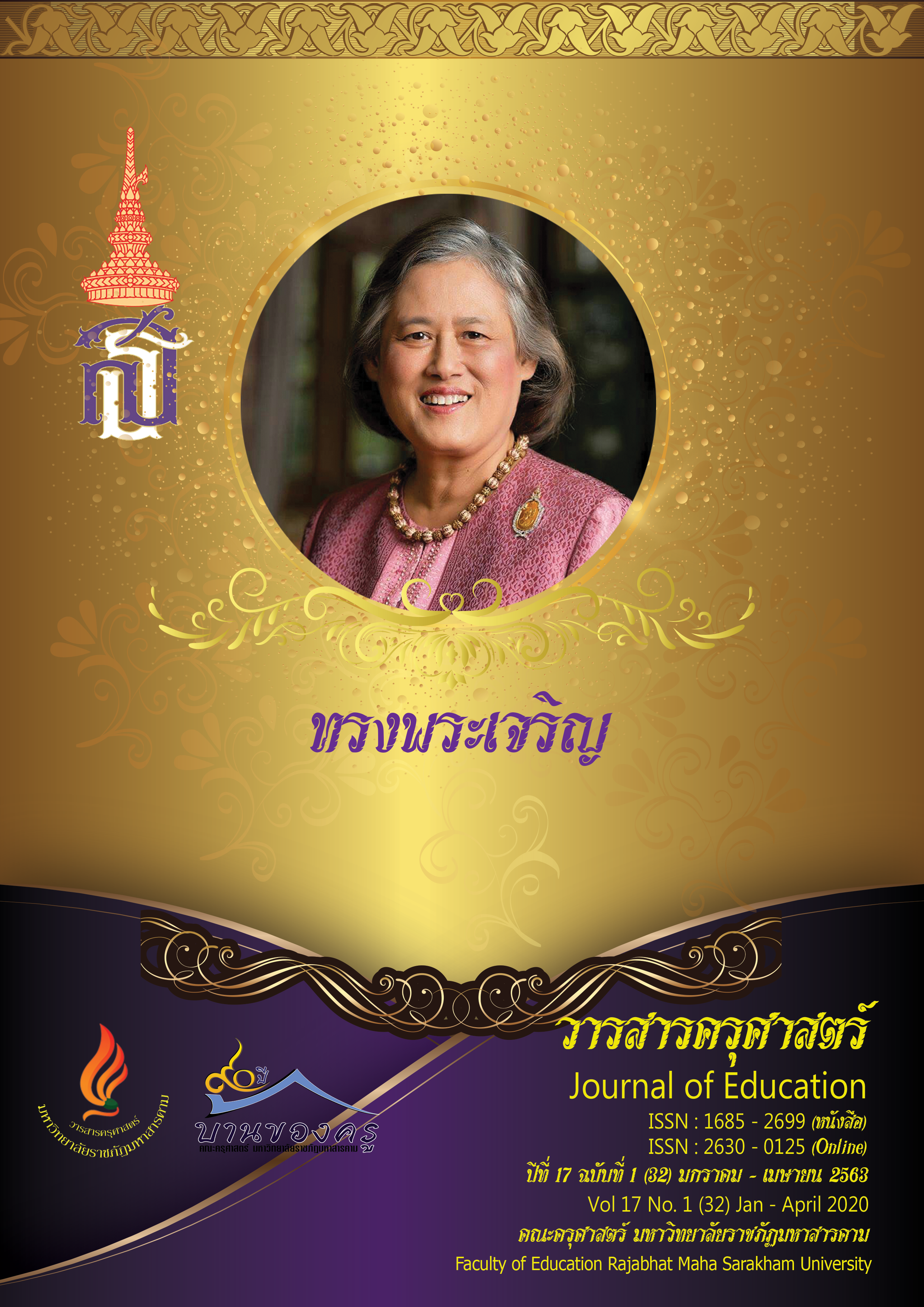Development of Online Interactive Learning Model Based on the Contemplative Education to Enhance Creative Thinking for Secondary School
Main Article Content
Abstract
The purposes of this research were: 1. to study the conditions and problems of teaching
and learning management of students in the computer subject field of secondary school, 2. to develop
of online interactive learning model and 3. to try out the online interactive learning model based on
the contemplative education to enhance creative thinking for secondary school. The study procedures
were divided into 3 phases. Phases 1: to study and analyze the problems and needs of students for
the online interactive learning model; Phases 2: to develop of online interactive learning model;
Phases 3: to the online interactive learning model based on the contemplative education to
enhance creative thinking for secondary school.
The research revealed that 1) The overall problem and needs of the students for Secondary
School, teaching and learning conditions have a lot of teaching and learning that emphasizes
content, learning management technology media does not draw attention and when they do not
understand or have questions who want to ask the teacher at any time, 2) the online interactive
learning model comprised 5 element as (1) the learner module (2) the coach module (3) the online
interactive module (4) the pedagogy module and (5) the evaluation module and 3) the results of
the satisfaction of learners studying with the develop of online interactive learning model at a high
level.
Article Details
ข้อกำหนดเบื้องต้นที่ผู้นิพนธ์(ผู้ส่งบทความ) ควรทราบ
1. ผู้นิพนธ์ที่ประสงค์จะลงตีพิมพ์บทความกับวารสาร ตั้งแต่เดือนมกราคม 2563 เป็นต้นไป ให้ใช้รูปแบบใหม่ (Template 2563) โดยสามารถดูตัวอย่างได้ที่เมนู GUIDELINES
2. จะตีพิมพ์และเผยแพร่ได้ ต้องผ่านการประเมินจากผู้ทรงคุณวุฒิ (Peer Review)
3. การประเมินบทความโดยผู้ทรงคุณวุฒิ (Peer Review) เป็นแบบ Double Blind
4. การอ้างอิงบทความใช้หลักเกณฑ์ APA (American Psychological Association) คลิก
5. บทความถูกปฏิเสธการตีพิมพ์ ไม่ผ่านการประเมิน ผู้นิพนธ์ขอยกเลิกเองหรือชำระเงินก่อนได้รับการอนุมัติ ทางวารสารไม่มีนโยบายการคืนเงิน
References
ขจรพงษ์ ร่วมแก้ว. (2560). พัฒนารูปแบบการเรียนรู้แบบเปิดตามแนวคิดคอนเน็คติวิสต์ซึมเพื่อส่งเสริมให้ผู้เรียนมีความคิดสร้างสรรค์ (วิทยานิพนธ์ปริญญาปรัชญาดุษฎีบัณฑิต). มหาวิทยาลัยราชภัฎมหาสารคาม,มหาสารคาม.
จารุณี ซามาตย์. (2552). การพัฒนาโมเดลสิ่งแวดลอ้ มการเรียนรู้บนเครือข่ายตามแนวคอนสฅรัคติวิสต์ที่ส่งเสริมการคิดสร้างสรรค์ของนักศึกษาระดับอุดมศึกษา (วิทยานิพนธ์ปริญญาปรัชญาดุษฎีบัณฑิต).มหาวิทยาลัยขอนแก่น, ขอนแก่น.
นิตยา ธัญญพาณิชย์. (2554). สรุปผลการประเมินคุณภาพการศึกษา ประจำปีการศึกษา 2553. สงขลา:มหาวิทยาลัยราชภัฏสงขลา.
บุญชม ศรีสะอาด. (2541). การพัฒนาการสอน. กรุงเทพมหานคร: สุวีริยาสาส์น.
ประเวศ วะสี. (2550). การเรียนรู้ใหม่ไปให้พ้นวิกฤต. กรุงเทพมหานคร: รว่ มด้วยช่วยกัน.
ประหยัด จิระวรพงศ์. (2549). การเรียนรู้ตามการพัฒนาของสมอง (Brain-Based Learning: BBL). ชลบุรี:มหาวิทยาลัยบูรพา.
ภัทรภร แสงไชย. (2551). การวิเคราะห์ผลของปฎิสัมพันธ์ระหว่างการสอนแบบแก้ปัญหาโดยอิงทฤษฎีสามศรกับรูปแบบการแก้ปัญหาที่มีต่อความสามารถในการแก้ปัญหาเชิงสร้างสรรค์และผลสัมฤทธิ์ทางการเรียนคณิตศาสตร์ของนักเรียนชั้นมัธยมศึกษาปีที่ 3 (วิทยานิพนธ์ปริญญาศึกษาศาสตรมหาบัณฑิต).มหาวิทยาลัยมหาสารคาม, มหาสารคาม.
วิชัย วงษ์ใหญ่. (2543). กระบวนทัศน์ใหม่ในการพัฒนาหลักสูตร. นนทบุรี: มหาวิทยาลัยสุโขทัยธรรมธิราช.ศูนย์วิจัยมหาวิทยาลัยกรุงเทพ (กรุงเทพโพลล์) (2555, 21 พฤศจิกายน). ความมั่งคั่งของประเทศไทย ท่ามกลางภัยจากเศรษฐกิจโลกปี 2013. ณ โรงละคอน ชั้น 16 อาคาร ดร.เจริญ คันธวงศ์ มหาวิทยาลัยกรุงเทพ(วิทยาเขตกล้วยนํ้าไท). กรุงเทพมหานคร, ประเทศไทย.
สุพิชญา โคทวี. (2553). จิตตปัญญาศึกษาทางเลือกใหม่ของการศึกษาไทย. วารสารครุศาสตร์ มหาวิทยาลัยราชภัฏอุตรดิตถ์, 8(2), 41-52.
อารี รังสินันท์. (2547). ฝึกให้คิดเป็น คิดให้สร้างสรรค์ (พิมพ์ครั้งที่ 3). กรุงเทพมหานคร: ใยไหม.
. (2532). ความคิดสร้างสรรค์. กรุงเทพมหานคร: ข้าวฟ่าง.
Andrea, R. M. (2008). The effects of constructivist classroom contextual factors in a life science laboratory and a traditional science classroom on elementary students’ motivation and learning strategies. United State: The University of Toledo.
Guiford, J. P. (1962). Factors that aid and hinder crativity. Teachers College Record, 6(3), 380-392.
Olatoye, R. A. (2010). Relationship between creativity and academic achievement of business administration students in South Western Polytechnics, Nigeria. An International Multi-Disciplinary Journal, Ethiopia, 4(3a), 134-149.
Zirak, M. (2015). The relationship between emotional intelligence and creative thinking with academic achievement of primary school students of fifth grade. Mediterranean Journal of Social Sciences, 6(1), 598-611. doi: 10.5901/mjss.2015.v6n1p598


